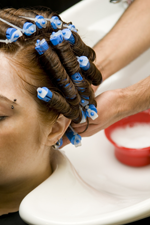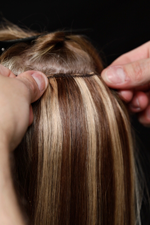Unwanted colour removal
In this case the Claimant attended the Defendant presenting naturally light brown hair, which had been dyed a permanent dark brown. The Claimant desired her hair colour lifting to a light blond. No pre-testing of any kind was carried out.
The Defendant used a bleaching reagent to strip the colour from the Claimant's hair. This bleach was left on the Claimant's hair and scalp for four times the recommended development time for chemically treated hair.
The misuse of this method of colour removal resulted in the Claimant sustaining injuries to her scalp, which were second-degree chemical burns. These burns wept profusely and later scabbed over. The scabs fell off within a week, taking her hair with them and leaving the Claimant with temporary bald patches.
The Claimant's remaining hair was chemically damaged and over-processed to such a degree that it caused Trichorrhexis Nodosa, abrasion to the hair cuticle and Fragilitis Crinium, which resulted in 30% hair loss throughout the lengths of her hair.
The Defendant exhibited a cavalier attitude towards the welfare of the Claimant.
It would take 4 ½ years before the Claimant's hair returned to the length and condition it was in prior to the incident.
Permanent Waving
The Claimant attended the Defendant presenting long, naturally dark brown hair, which was in a good condition. The claimant desired soft curls in her hair. No skin tests, strand tests, or test curls were implemented.
Excessive amounts of perming reagent were applied to the Claimant's hair, which caused it to seep onto the scalp and surrounding skin. This resulted in Primary Irritant Contact Dermatitis of the scalp and may mean that the Claimant's scalp will have become sensitised and cannot have any further chemical hairdressing treatments in the future.
The reagent was far too strong for the Claimant's hair type and was left to develop for much longer than the recommended processing time, which left the Claimant's hair four shades lighter and a reddish brown in colour.
The Claimant suffered massive breakage at scalp level to the vertex (top) of her scalp, due to excessive tension when winding the hair onto the perm rods. She lost 90% of her hair in this region.
The remaining hair throughout her scalp was covered in nodules of Trichorrhexis Nodosa, which broke at intervals over the following weeks. These nodules were so large that they were clearly visible to the naked eye. Her hair was left dry, coarse and brittle. The Claimant was unable to comb through her hair.
It would take 4 years before the Claimant's hair returns to the length and condition it was in prior to the incident.
Hair Extensions
The Defendant carried out a consultation, in which the Claimant informed her of the recent birth of her child. The Defendant did not apply any sample meshes to her hair to test it.
When she returned for the meshes fitting, she was surprised that they were on a long strip, rather than individual meshes she had seen fitted previously.
As soon as they were applied they felt uncomfortable and were pulling at the hairs on her scalp. The Claimant did not know what to expect as she had not had extensions fitted before so she assumed they would be okay.
The only information she was given to the care of them was that she must condition them and that they would last 6 months.
For 5 days, the extensions pulled painfully at the Claimant's hair. On the 5th day her mother noticed that she was developing bald areas around the meshes. She returned to the Defendant who advised that this had never happened before and glued them back in place.
The Claimant's scalp became tender and itchy and she found it difficult to lay on her hair as the extensions pulled and felt extremely painful.
She returned again to the Defendant a few days later to have them removed. The Defendant applied lots of conditioner in an attempt to remove them but they would not come out so she pulled them out, ripped much of the Claimant's own hair with them. This procedure took a very painful 4 hours!
The Claimant was extremely upset to see bald areas in strips along her scalp where the extensions had been removed.
Eventually the Claimant's hair grew back in tufts, which looked unsightly for a time. Her scalp was red and tender for some time after the incident. Her GP prescribed her anti-depressants as a direct result of the incident.
Upon examination, some seven months later, the areas of loss were still visible. The strip, which had been placed nearest the vertex had not fully recovered and was presenting very fine hairs in this area.
The Claimant suffered Traumatic Traction Alopecia, which may have caused permanent damage to the Claimant's hair follicles in this area and will need to be reassessed 6 months later to give an accurate prognosis. The extension meshes were too large and heavy and microscopic analysis of the samples showed that hair had been taken from too large an area causing traction from the wider perimeter of the supporting meshes of hair.
The Defendant did not exercise sufficient care and skill in fitting the extensions and she did not give the Claimant full information of the possible risks involved for the Claimant to make an informed decision for them to be fitted.

